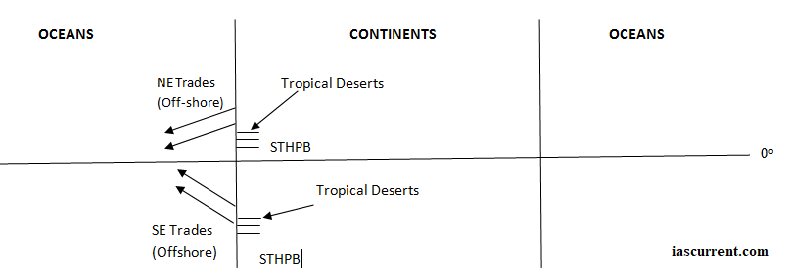In this section, we will discuss Winds, their types. The horizontal flow of air is described as the wind. The movement and direction of winds are controlled by these four forces; Pressure gradient force, Centripetal force, Coriolis force, and Frictional force. We will discuss these forces later in this section.
Types of Winds
On the basis of their origin, winds are classified into 3 categories;
- Primary Winds 2.Secondary Winds 3. Tertiary Winds
Primary Winds
These are also called planetary winds or permanent winds. These are called permanent winds as their flow is uniform throughout the year due to the fact that these winds flow between permanent pressure belts. These are also called planetary winds as these are most extensive on the surface of the earth. These winds are called primary winds as these are most extensive, must dominant & most permanent with respect to their flow between perennial &permanent pressure belts. These are four primary winds;
Doldrums
Doldrums are strong air currents convectively rising from the lower troposphere to the upper troposphere above the hot equatorial surface. Doldrums create windless conditions.
Equatorial westerlies are formed during the summer of a given hemisphere due to the shifting of the ITCZ towards north while the mid-day sun is above the Tropic of Cancer or towards South while the mid-day sun is above the Tropic of Capricorn. Under such conditions, the trade winds cross the equator and get deflects under the influence of Coriolis force to form equatorial westerlies in each hemisphere during the summers of that hemisphere. Equatorial westerlies and doldrums produce rainfall throughout the year in the equatorial regions.
Trade Winds
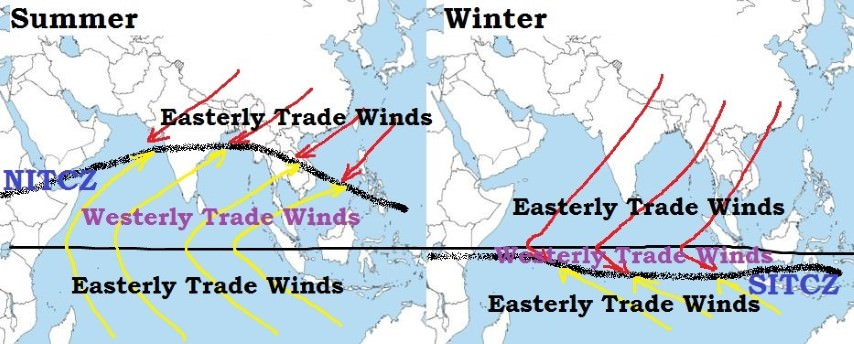
These winds flow from Sub-Tropical High-Pressure Belt to the Equatorial Low-Pressure Belt. These are called North East trade winds in the southern hemisphere because of their consistent availability and uniform flow; these winds have been beneficial for ocean navigation and movement in ancient times. Trade winds carry moisture from high latitudes to low latitudes.
Tropical Deserts, also called hot & dry deserts, are located on this hot west coast of continents in subtropical regions where the trade winds are off-shore i.e. flowing from land to sea throughout the year.
Westerlies
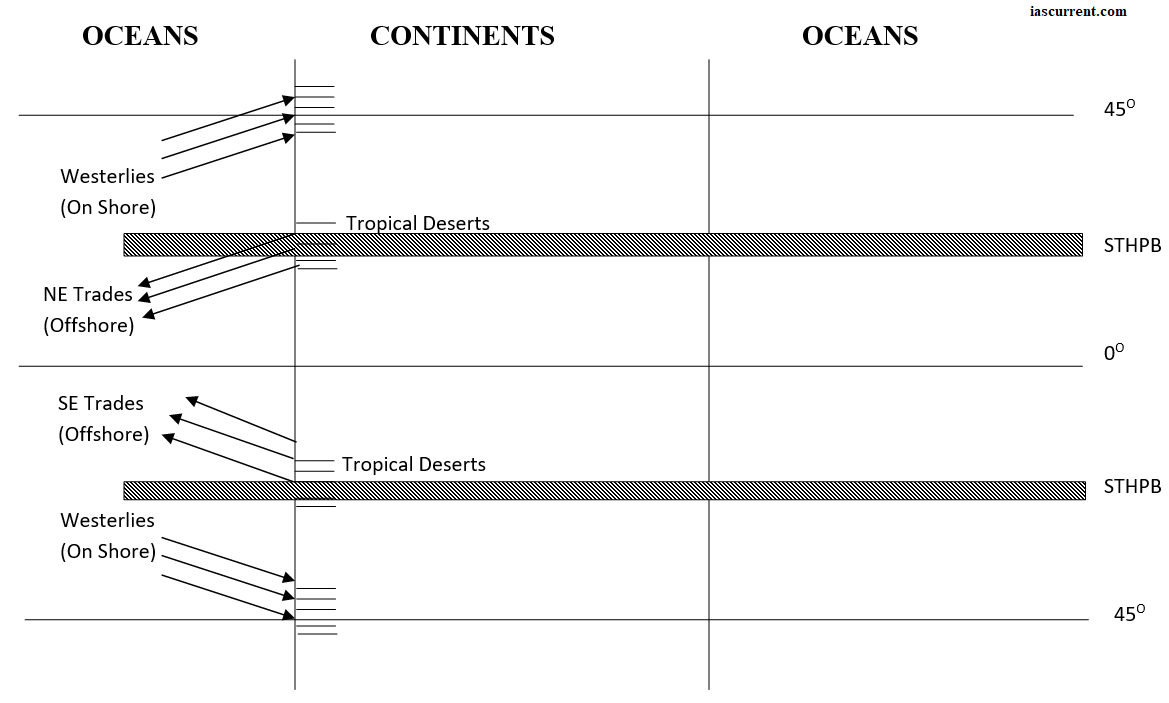
Westerlies flow from Sub-Tropical high-pressure belts to Sub-Polar Low-Pressure Belts; these are strong winds that generate rainfall on the west coast of continents in mid-latitudes as these are on-shore throughout the year.
The velocity of the westerlies is higher as they are farther away from the equator (Law of Conservation of angular momentum, as radius decreases; velocity increases).
Westerlies are particularly strong in the southern hemisphere where their flow is uninterrupted due to the absence of any landmass and the presence of an extensive oceanic surface. Such westerlies are known as The Roaring Forties (40°S), The Furious Fifties (50°S), and The Shrieking Sixties (60°S), named so by ancient mariners and navigators.
Polar Easterlies
These flow from polar high-pressure belts to sub-polar low-pressure belts. These are extremely cold winds that produce heavy snowfall.
Secondary Winds/Seasonal Winds
There is a periodic change in their direction. Their periodicity is according to Day/Night and summer/winter i.e., Diurnal & Seasonal Periodicity respectively. The major secondary winds include:
- Land & Sea Breeze.
- Valley and Mountain.
- Monsoon Winds: North East Monsoon (winters) & South West Monsoon (summers)
Land and Sea Breeze
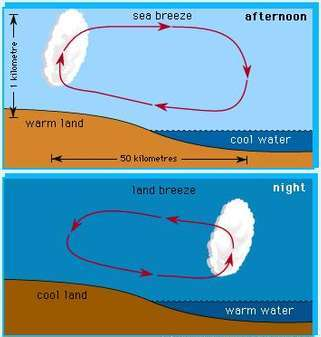
Land and sea breeze emerge from diurnal changes in the coastal regions. During the daytime, the land surface gets heated up faster than oceans due to the high specific heat of the water. As a consequence, the overlying air on the landmass gets heated up and expands in the daytime. As a result, low pressure is developed over the landmass. This is why the wind/breeze flows from the ocean/sea to land during day time. This sea breeze maintains the temperature of the land, keeping it moderate it aids, in the onshore movement of fishermen.
Conversely, at night the landmasses get cooled off faster than seawater. Seawater retains the heat gained during the daytime resulting in high pressure over land masses and relatively low pressure over oceans. Therefore, wind flows from the land to the sea in this case. This is how the land breeze operates during night time and winter. Land breeze aids in the offshore movement of fishermen deep into the seas. The above-mentioned reason is why coastal regions are extremely beneficial for wind farms –for the generation of wind ENERGY.
Valley & Mountain Breeze
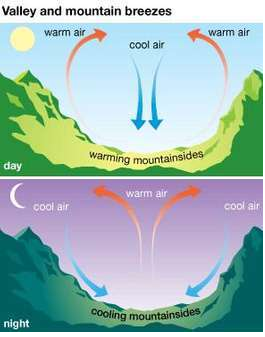
During summers/daytime, the incoming solar short wave radiation heats up mountain tops and valley floors, differently. Since the thickness of the atmosphere is greater for valley floors, the incoming solar radiation undergoes greater scattering. Therefore, the valley floor is a zone of low temperature and high pressure.
Meanwhile, mountain tops are heated more since the Solar Insulation has a smaller path to cover along with their atmosphere. Mountains tops are zones of high temperature & low pressure. Consequently valley breeze flow to mountain tops. At night Time Mountain Breeze blows from mountain tops to valley floors due to the opposite reason.
Monsoon Winds
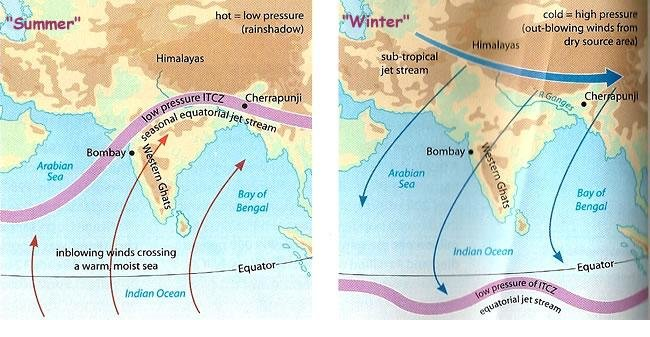
According to the earlier theory of monsoon, monsoon winds are extensive land and sea breeze. Their origin is associated with the differential heating and cooling of land and water. Accordingly, during summers, low pressure is formed over the Great Plains and high pressure is developed over the cooler surface of oceans. Consequently, winds blow from sea to land, the wind being deflected to their right side in the Northern hemisphere to form the South West monsoon winds.
During the winter season, the great plains are at low temperatures resulting in the development of high-pressure inland. The Indian Ocean on the other hand is relative; warmer and this low pressure is developed in the oceans. Home NE trade winds are formed monsoon on the east coast bring and leeward areas.
Tertiary Winds
Their origin is topographical. Since these are originating from landforms, they will be dry in nature. On the basis of their thermal properties, they are broadly clarified as under:
Hot & Dry Winds
Hot and dry winds are further clarified to thermally generated and adiabatically generated hot and dry winds. Winds that originate in the TROPICAL DESERTS originate from thermal heating whereas winds that originate from the {leeward side of mountains} originate from adiabatic compression and consequent heating.
Thermally Generating Hot & Dry Winds
These originate from Tropical deserts during the summers when the surface becomes extremely hot. Some locally known winds are :
Adiabatically Originating Hot & Dry Winds
These are originating out of adiabatic heating on the leeward side of the mountains in close proximity to the coast. Such winds that flow on the leeward side of mountains are dry and devoid of moisture. Then descent down the slope compresses the underlying mass of air adiabatically, thus increasing the temperature.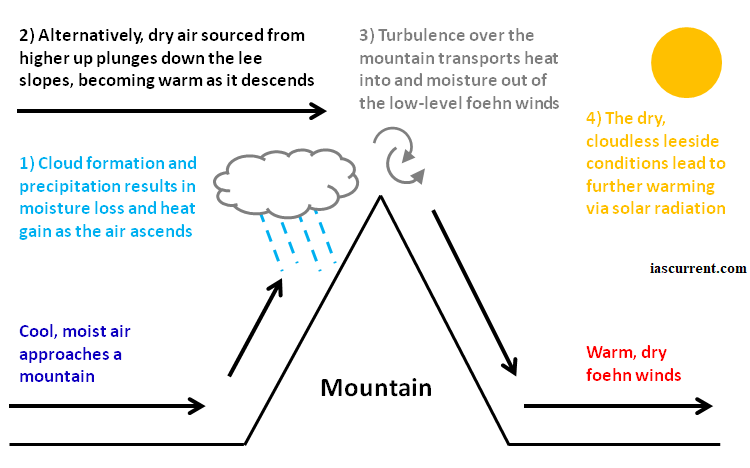
A case in point is the wind called “Chinook” in North America. Chinook is an Indian word meaning “the Snow eater”. Chinook flows down the leeward slope of the Rockies after losing all its moisture that the westerlies had in the form of onshore westerlies. This adiabatically compressing hot wind drives down the winter snow form of the Rockies, melting it en route to the Great Plains of America (The Prairies).
“Zonda” is a similar wind that blows down the leeward side of the Andes towards the Pampas Green lands of South America. “Foehn” is a similar kind of wind that flows down the leeward side of The European Alps, especially (mainly) in Switzerland.
Cold & Dry Winds
Cold and dry winds originate in a place covered by ice caps and glaciers. These originate thus in Polar Regions. The extremely cold and dry and snowfall producing winds originating in Polar Regions are called blizzards.
Cold and dry winds also originate in high mountain ranges producing heavy snowfall in winters. These cold and dry mountain winds have local names as under:

Types of forces controlling the movement of Winds
The movement and direction of winds are controlled by these four forces; Pressure gradient force, Centripetal force, Coriolis force, and Frictional force.Pressure Gradient Force
Pressure gradient force determines the initial direction and velocity of air. It is defined as the rate of change pressure. The velocity of wind is directly proportional to the rate of change of pressure. The pressure gradient force is high while the isobars are close to each other & are low when the isobars are far away from each other.
Coriolis force
This is related to the rotation of the earth. Coriolis force works both on northerly and southerly winds. It deflects wind to its Right-hand side in the northern hemisphere and to its Left-hand side in the southern hemisphere with respect to the point of origin of the wind.
Centripetal Force
It is also related to the rotation of the earth. It helps in the development of circulatory systems like cyclones and anticyclones. Circulation is in the direction of deflection in each hemisphere.
Friction Force
Friction depends on the altitude, orientation, and nature of natural and man-made structures. It is a minimum above the oceanic surface.


